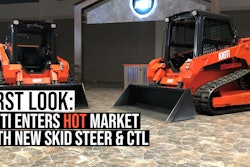
Articulated trucks aren’t the first thing that come to mind when considering technological advancements in construction equipment, but there’s no doubt they’re getting smarter.
One goal of this technology is “to remove the guesswork while leaving the operator in control,” says Cory Brant, solutions marketing manager, John Deere.
This technology goes way beyond onboard weighing and tracking, says Scott Thomas, Cat product application specialist. “The repetitive nature of the work done by these trucks makes them ideal candidates for having multiple automated functions,” he says.
Here’s a look at the various advancements occurring with ADTs from Caterpillar, John Deere, Komatsu, Bell, Doosan, Terex Trucks and Volvo Construction Equipment:
Removing guesswork
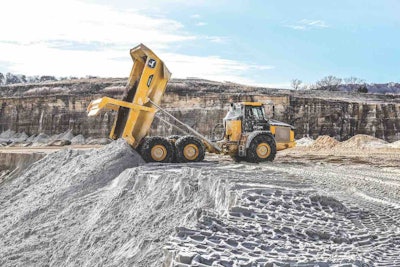 E-II Series trucks from John Deere feature redesigned dump bodies. The new design is wider and lower with a level rail height and angled bin rail for improved material retention. An optional ejector body is available for the 460E-II. Ejector dumps offer safety benefits but also allow more controlled spreading of bin contents with the truck in motion.
E-II Series trucks from John Deere feature redesigned dump bodies. The new design is wider and lower with a level rail height and angled bin rail for improved material retention. An optional ejector body is available for the 460E-II. Ejector dumps offer safety benefits but also allow more controlled spreading of bin contents with the truck in motion.Brant cites the three operating modes of Deere’s new 410E-II and 460E-II artics as an example of ways the company is assisting operators with advanced technology:
Normal mode enables the new E-II machines to perform similarly to their predecessors, the E Series trucks, but with improved fuel economy.
Eco mode “just smooths out the machine” in shifting, acceleration, braking and other operations. It’s what a highly skilled operator would do in seeking maximum fuel efficiency, but Eco mode does it automatically, all day, every day.
Traction mode takes the guesswork out of the auto-differential lock and matches engine speed and shift points to conditions.
Deere also simplified greasing on the 410E-II and 460E-II. A bank of easily accessible zerks has lines running to the lube points. Auto-lube is a factory option; it retains the ability to manually service grease points.
Cab updates include optional automatic HVAC temperature control, simplified transmission retarder settings and multifunction switches. E-II models also feature wider, lower dump bodies for faster and easier loading.
Gaining traction
 Komatsu’s HM400-5 is powered by a Komatsu engine rated at 469 horsepower. Gross vehicle weight is 165,644 pounds and payload capacity is 44.1 tons. The low 10-foot, 5-inch load height is a good match for 40- to 60-ton excavators or 5.5- to 7.5-cubic-yard wheel loaders. A lightweight fiberglass hood features an electrically powered tilt function as standard equipment.
Komatsu’s HM400-5 is powered by a Komatsu engine rated at 469 horsepower. Gross vehicle weight is 165,644 pounds and payload capacity is 44.1 tons. The low 10-foot, 5-inch load height is a good match for 40- to 60-ton excavators or 5.5- to 7.5-cubic-yard wheel loaders. A lightweight fiberglass hood features an electrically powered tilt function as standard equipment.Komatsu Traction Control System monitors both travel speed and individual wheel speed. When slippage is detected, it engages the interaxle lock. If additional control is needed, the system applies the brakes individually to the slipping wheels and sends power to the wheels that have traction.
“Eliminating the need for lock on the differential preserves a higher level of steering capability and reduces tire wear without compromising travel performance,” says Sebastian Witkowski, product marketing manager, Komatsu.
Witkowski also calls attention to the Komatsu Advanced Transmission with Optimum Modulation Control System (K-ATOMiCS), a fully automated six-speed transmission designed to minimize shift shock and torque loss. Advanced computer logic uses the haul profile, engine speed, throttle position and more to optimize both up- and downshifting.
Informative co-pilot
 The 630-horsepower Volvo A60H has a payload capacity of 61 tons and 43.9 cubic yards heaped. The front grill swings down to provide a service platform with anti-slip steps, while the electric hood opens 90 degrees for full access to the engine compartment. Onboard weighing data and other information are displayed on the 10-inch Co-Pilot display using the Haul Assist feature.
The 630-horsepower Volvo A60H has a payload capacity of 61 tons and 43.9 cubic yards heaped. The front grill swings down to provide a service platform with anti-slip steps, while the electric hood opens 90 degrees for full access to the engine compartment. Onboard weighing data and other information are displayed on the 10-inch Co-Pilot display using the Haul Assist feature.Volvo ADTs have Haul Assist, which includes onboard weighing, as do many ADTs. But it also works within the Volvo Co-Pilot architecture to deliver additional information.
Co-Pilot stores site information and can show how much of a specific material was brought to each dump site. It can monitor production against target values for each project. Simple graphics display tons per hour, tons per unit of fuel, percent of truck utilization and amount of carryback.
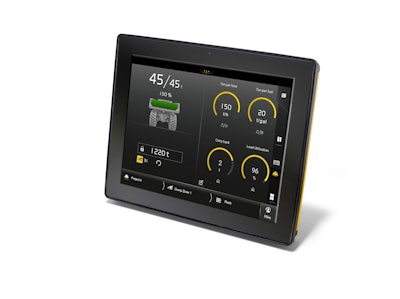 Volvo Haul Assist
Volvo Haul AssistA site map shows load and dump zones, areas with special considerations (reduced speed limits, narrow roads, etc.) and the proximity of other trucks on site that are also equipped with Co-Pilot.
“Because Co-Pilot offers standard features in all applications, operators of other Co-Pilot-equipped machines find the system familiar and intuitive as they move from one type of equipment to another,” says Rob Palermo, product manager, articulated haulers, Volvo.
Pedestrian detection
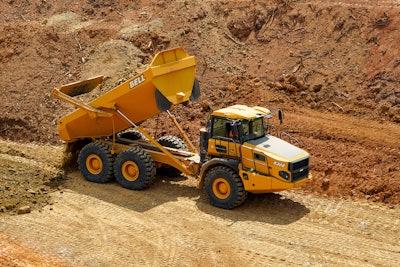 The Bell B30E is powered by a Mercedes-Benz inline, turbocharged 6-cylinder engine rated at 348 gross horsepower. Empty weight is 44,776 pounds. Payload rating is 30.8 tons. Two double-acting, single-stage dump cylinders give a raise time of 14.5 seconds and a lowering time of 7.5 seconds.
The Bell B30E is powered by a Mercedes-Benz inline, turbocharged 6-cylinder engine rated at 348 gross horsepower. Empty weight is 44,776 pounds. Payload rating is 30.8 tons. Two double-acting, single-stage dump cylinders give a raise time of 14.5 seconds and a lowering time of 7.5 seconds.Effective with the 2021 models, all Bell articulated trucks come configured for a pedestrian detection system (PDS).
Bell provides the interface and electronically controlled brake valve required for PDS. Only suppliers that have successfully tested their PDS interface with Bell can install the equipment on these trucks. If PDS detects a safety threat, including a nearby person, it signals the truck, and the truck applies the brakes.
Bell’s new B30E Pin 3.0 comes with an Allison 3400 ORS fully automatic transmission with six forward speeds and one reverse. A key feature is xFE for improved fuel economy. More torque-converter lockup results in more time in higher gear ranges at lower engine speed. FuelSense shift calibration, a set of proprietary software enhancements developed by Allison, optimizes shift points to match the haul profile, yielding higher shift rpm on steeper grades and lower shift rpm on flatter terrain. Throughout the day, trucks with xFE run at lower average engine speed and thereby use less fuel.
“The old calibration was called ‘table-based’ shifting,” says Robin Pett, product manager, Bell Equipment North America. “This had a set engine rpm at which a shift would occur. The new FuelSense calibration generally shifts at a lower engine rpm for better fuel efficiency when conditions allow but will hold a gear until a higher engine speed is attained as required by conditions.”
There is no transmission retarder in the B30E. Instead, it has a brake retarder using the service brakes, which are on only the front and middle axles. The brake retarder pulls the wet disc-brake pads near the rotors but stops short of actual contact. Oil shear between the pads and discs provides the retarder effect. The middle and rear axles are connected so that braking of the middle axle transmits braking force to the rear axle wheels. Brakes have been upgraded to eight plates and supply significantly greater braking force than did the former six-plate wet disc brakes. An engine brake engages automatically whenever the operator’s foot is lifted from the accelerator pedal.
Fuel savings
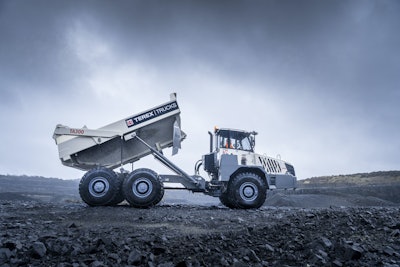 The Terex TA300 has a Scania DC9 engine rated at 370 gross horsepower mated to an EP320 transmission. Rated capacity is 30.9 tons or 22.9 cubic yards heaped. An independent front suspension improves comfort and traction. Fully enclosed, oil-cooled, multi-disc brakes at all six wheels provide strong stopping power. The cab features tilt/telescope steering, an adaptive air suspension seat with adjustable armrests and acoustic insulation for noise reduction.
The Terex TA300 has a Scania DC9 engine rated at 370 gross horsepower mated to an EP320 transmission. Rated capacity is 30.9 tons or 22.9 cubic yards heaped. An independent front suspension improves comfort and traction. Fully enclosed, oil-cooled, multi-disc brakes at all six wheels provide strong stopping power. The cab features tilt/telescope steering, an adaptive air suspension seat with adjustable armrests and acoustic insulation for noise reduction.The TA300 from Terex Trucks is now equipped with an EP320 transmission with eight forward and four reverse gears. This provides a higher overall gear ratio spread, equal-ratio steps between gears and optimized shifting with partial loads. The EP320 contributes to the TA300 seeing a 5 percent improvement in fuel efficiency over the previous model.
Top speed is increased by 3.1 mph to 34 mph. The EP320 transmission-fluid maintenance interval is extended to 4,000 hours. The main hydraulic reservoir, equipped with magnetic suction filters and high-performance oil, also has extended service intervals of up to 4,000 hours.
The TA400 has the latest drop-box design for higher levels of performance and durability. An electronically activated engine-exhaust brake and six-stage modulating transmission retarder support the force-cooled disc brakes, extending their life. The Allison HD4500 on the TA400 has fluid maintenance intervals of up to 6,000 hours. As with the TA300, hydraulic fluid maintenance is scheduled for 4,000 hours.
Hydro-gas self-leveling
 Doosan debuted two new ADTs at ConExpo 2020, the DA30-5 and DA45-5 (shown). The DA45-5 started as a DA40 and was upgraded to handle a 45-ton payload. Both trucks come with active payload measuring as standard. The DA45-5 has 500 horsepower and an empty weight of 66,359 pounds. The DA30-5 has 375 horsepower and an empty weight of 50,707 pounds.
Doosan debuted two new ADTs at ConExpo 2020, the DA30-5 and DA45-5 (shown). The DA45-5 started as a DA40 and was upgraded to handle a 45-ton payload. Both trucks come with active payload measuring as standard. The DA45-5 has 500 horsepower and an empty weight of 66,359 pounds. The DA30-5 has 375 horsepower and an empty weight of 50,707 pounds.Doosan uses a new front suspension on its DA30-5 and DA45-5, replacing shock absorbers and rubber springs with a hydro-gas, self-leveling system.
Ride quality and operator comfort are improved, especially when the truck is empty. The hydro-gas cylinders connect to pressure accumulators. The pressure in the cylinders can be adjusted to change ride characteristics and to lower the height of the truck for easier transport. A front-mounted turning ring gives better left-to-right weight distribution when turning.
Newly redesigned cabs on the Doosan DA30-5 and DA45-5 sport more than a dozen new features for improved ergonomics and comfort. Bigger gauges are easier to read. User-friendly graphics and icons can be controlled by buttons on the display panel. That panel can now show multiple camera views.
“Some of our customers add a second camera to get a view of the truck’s body to better monitor the payload,” says Aaron Kleingartner, product and dealer marketing manager, Doosan Infracore North America. “The second camera, when used in conjunction with our payload measuring system, can help operators determine when the payload is near its proper level.” Payload tracking is now standard on both Doosan ADTs.
One lever, multiple functions
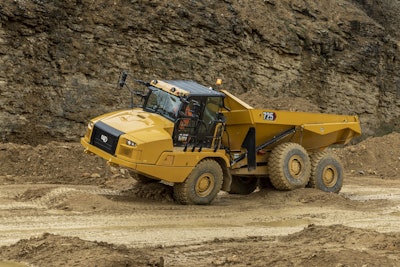 A Cat C9.3 engine rated at 342 gross horsepower drives the Cat 725. Heaped capacity is 19.6 cubic yards and rated payload capacity is 26.5 tons. The sum of the technological features on the 725 improves performance over the previous version, cutting required operator input as much as 50 percent.
A Cat C9.3 engine rated at 342 gross horsepower drives the Cat 725. Heaped capacity is 19.6 cubic yards and rated payload capacity is 26.5 tons. The sum of the technological features on the 725 improves performance over the previous version, cutting required operator input as much as 50 percent.The 725 is the last of Cat’s ADTs to get the company’s new cab and other new features.
Traction control is fully automatic. It is integrated with the steering system and senses when steering is active. This allows the truck to turn while still engaging the diff locks.
The automatic retarder turns off when the operator applies the throttle. While bigger Cat ADTs have engine retarders, the 725 relies on a hydraulic retarder bolstered by the service brakes when needed.
The combined transmission-hoist lever on the Cat 725 gives operators access to multiple functions.
In neutral, the thumb-actuated top button activates a wait brake, which temporarily applies the service brakes during pauses in the work cycle. The wait brake uses the service brakes, providing more braking power than a disc brake on the drive shaft.
In drive, that same button serves as a transmission hold. In the biggest models – the 740 EJ, 740 GC and 745 – it is the shifter for the two-speed reverse.
The second yellow button on the lever is a speed limiter, which sets a maximum top speed for the truck. Fingertip control is used to dump (or eject on EJ models).
If the truck is stopped or going less than 2 mph, Cat’s new Assisted Hoisting Control will shift to neutral, engage the service brakes, apply the wait brake, raise engine rpm and raise the dump body. Lowering the body is also an automated sequence, all done by pushing the control button past its detent, just like fully raising or lowering a power window in a vehicle.



